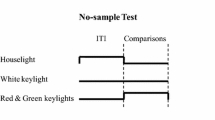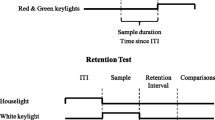Abstract
The present study examined whether the dual-element effect occurs when temporal and visual stimuli appear simultaneously in a zero-delayed, symbolic matching-to-sample task. Two groups of pigeons were first exposed to either a red or green sample stimulus, for either 30 s or 5 s. The sample was followed by the presentation of yellow and blue comparisons. For pigeons in one group, the duration of the sample was the relevant cue. Responses to the yellow comparison were reinforced if the sample was 30 s, and responses to the blue comparison were reinforced if the sample was 5 s. For the other group, sample duration was irrelevant. Responses to the yellow comparison were reinforced if the sample had been green and responses to the blue comparison were reinforced if the sample had been red. Both groups then learned a second matching task in which the sample and comparison stimuli were vertical and horizontal lines. Finally, matching performance was examined when the lines appeared together with the temporal or color elements. The results showed that the line matching task was acquired more slowly for pigeons that were first trained to attend to duration. More importantly, matching was reduced when the temporal and line elements appeared simultaneously, and the effects were similar to those obtained when visual elements are combined.
Similar content being viewed by others
References
BLOUGH, D. S. (1959). Delayed matching in the pigeon. Journal of the Experimental Analysis of Behavior, 2, 151–160.
BOWERS, R. L, & RICHARDS, R. W. (in press). Pigeons’ short-term memory for temporal and visual stimuli in delayed matching-to-sample. Animal Learning & Behavior.
CARTER, D. E., & WERNER, T. J. (1978). Complex learning and information processing by pigeons: A critical analysis. Journal of the Experimental Analysis of Behavior, 29, 565–601.
CHURCH, R. M., & MECK, W. H. (1983). Acquisition and cross-modal transfer of classification rules for temporal intervals. In M. L. Commons, R. J. Herrnstein, & A. R. Wagner (Eds.), Quantitative analyses of behavior: Discrimination processes (Vol. IV). Cambridge, MA: Ballinger.
COLAVITA, F. B. (1974). Human sensory dominance. Perception and Psychophysics, 16, 409–412.
COX, J. K., & D’AMATO, M. R. (1982). Matching-to-compound samples by monkeys (Cebus apella): Shared attention or generization decrement? Journal of Experimental Psychology: Animal Behavior Processes, 8, 209–225.
D’AMATO, M. R., & WORSHAM, R. W. (1972). Delayed matching in the Capuchin monkey with brief sample durations. Learning and Motivation, 3, 304–312.
DELONG, R. E., & WASSERMAN, E. A. (1985). Stimulus selection with duration as a relevant cue. Learning and Motivation, 16, 259–287.
FARTHING, G. W., WAGNER, J. M., GILMOUR, S., & WAXMAN, H. M. (1977). Short-term memory and information processing in pigeons. Learning and Motivation, 8, 520–532.
GRANT, D. S. (1976). Effect of sample presentation time on long-delay matching in the pigeon. Learning and Motivation, 7, 580–590.
GRANT, D. S., & MACDONALD, S. E. (1986). Matching to element and compound samples in pigeons: The role of sample coding. Journal of Experimental Psychology, 12, 160–171.
GRANT, D. S., & ROBERTS, W. A. (1973). Trace interaction in pigeon short-term memory. Journal of Experimental Psychology, 101, 21–29.
HERMAN, L. M. (1975). Interference and auditory short-term memory in the bottlenose dolphin. Animal Learning and Behavior, 3, 43–48.
HOLT, G. L, & SHAFER, J. N. (1973). Function of intertriai interval in matching- to-sample. Journal of the Experimental Analysis of Behavior, 19, 181–186.
KENDRICK, D. F., RILLING, M., & DENNY, M. R. (1986). Theories of animal memory. Hillsdale, NJ: Lawrence Erlbaum Associates.
KRAEMER, P. J., & ROBERTS, W. A. (1985). Short-term memory for simultaneously presented visual and auditory signals in the pigeon. Journal of Experimental Psychology: Animal Behavior Processes, 11, 137–151.
LAMB, M. R., & RILEY, D. A. (1981). Effects of element arrangement on the processing of compound stimuli in pigeons (Columbia livia). Journal of Experimental Psychology: Animal Behavior Processes, 7, 45–58.
MAKI, W. S., Jr., & LEITH, C. R. (1973). Shared attention in pigeons. Journal of the Experimental Analysis of Behavior, 19, 345–349.
MAKI, W. S., Jr., & LEUIN, T. C. (1972). Information processing by pigeons. Science, 176, 535–536.
MAKI, W. S., Jr., MOE, J. C, & BIERLEY, C. M. (1977). Short-term memory for stimuli, responses, and reinforcers. Journal of Experimental Psychology: Animal Behavior Processes, 3, 156–177.
MAKI, W. S., Jr., RILEY, D. A., & LEITH, C. R. (1976). The role of test stimuli in matching to compound samples by pigeons. Animal Learning and Behavior, 4, 13–21.
MARSH, G. (1969). An evaluation of three explanations for the transfer of discrimination effect. Journal of Comparative and Physiological Psychology 68, 268–275.
NELSON, K. R., & WASSERMAN, E. A. (1978). Temporal factors influencing the pigeon’s successive matching-to-sample performance: Sample duration, intertriai interval, and retention interval. Journal of the Experimental Analysis of Behavior, 30, 153–160.
POSNER, M. I., NISSEN, M. J., & KLEIN, R. M. (1976). Visual dominance: An information-processing account of its origins and significance. Psychological Review, 83, 157–171.
RICHARDS, R. W., & BOWERS, R. L. (1985). Dual-element effects in a one-key matching task with simultaneous and sequential elements. The Psychological Record, 35, 575–582.
RILEY, D. A., COOK, R. G., & LAMB, M. R. (1981). A classification and analysis of short-term retention codes in pigeons. In G. H. Bower (Ed.), The psychology of learning and motivation. New York: Academic Press.
RILEY, D. A., & ROITBLAT, H. L. (1978). Selective attention and related cognitive processes in pigeons. In S. H. Hulse, H. Fowler, & W. K. Honig (Eds.), Cognitive processes in animal behavior. Hillsdale, NJ: Lawrence Erlbaum.
ROBERTS, S. (1982). Cross-modal use of an internal clock. Journal of Experimental Psychology: Animal Behavior Processes, 8, 2–22.
ROBERTS, W. A., & GRANT, D. S. (1974). Short-term memory in the pigeon with presentation time precisely controlled. Learning and Motivation, 5, 393–408.
ROBERTS, W. A., & GRANT, D. S. (1978). Interaction of sample and comparison stimuli in delayed matching to sample with the pigeon. Journal of Experimental Psychology: Animal Behavior Processes, 4, 68–82.
ROITBLAT, H. L, BEVER, T. G., & TERRACE, H. S. (1984). Animal cognition. Hillsdale, NJ: Lawrence Erlbaum Associates.
SANTI, A., GROSSI, V., & GIBSON, M. (1982). Differences in matching-to- sample performance with element and compound sample stimuli in pigeons. Learning and Motivation, 13, 240–256.
SUTHERLAND, N. S., & MACKINTOSH, N. J. (1971). Mechanisms of animal discrimination learning. New York: Academic Press.
Author information
Authors and Affiliations
Additional information
This research is dedicated to Henry A. Cross, who retired recently from a productive career at Colorado State University.
Rights and permissions
About this article
Cite this article
Bowers, R.L., Richards, R.W. Dual-Element Effects in Pigeons’ Matching-to-Sample with Temporal and Visual Stimuli. Psychol Rec 40, 259–271 (1990). https://doi.org/10.1007/BF03399563
Published:
Issue Date:
DOI: https://doi.org/10.1007/BF03399563




